You can power a TV with a power bank, but you'll need to match the TV's wattage and voltage to the power bank's output. Most power banks are designed for low-power devices and might not have sufficient capacity or output for a TV. Check the TV's power requirements—typically 12V to 19V and 30W to 100W—and guarantee your power bank can meet these demands. Also, consider connection methods and safety features like overload protection. For an effective and safe setup, understanding these compatibility details is essential. Explore further to make an informed decision.
Understanding Power Banks
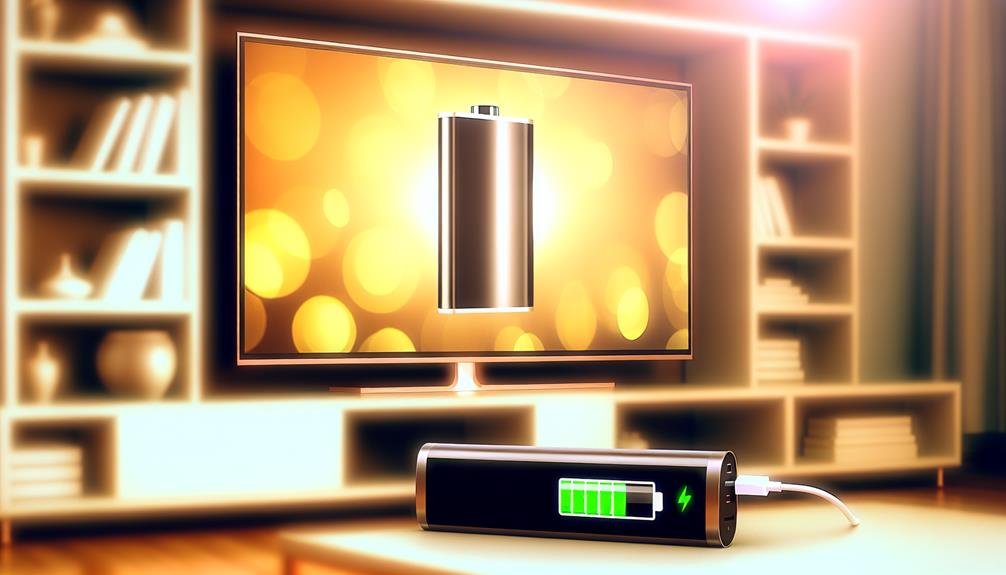
A power bank, fundamentally a portable battery, stores electrical energy and can supply power to various devices through USB ports. Understanding how a power bank operates is essential for ensuring safe and efficient use. When assessing a power bank, you need to take into account charging time and efficiency. Charging time refers to how long it takes to fully charge the power bank itself. This can vary based on the capacity of the battery and the input power. Efficiency, on the other hand, measures how effectively the stored energy is transferred to your devices. Higher efficiency means less energy loss during the transfer process.
Battery life and performance are also critical factors. Battery life indicates how many charge cycles a power bank can undergo before its capacity starts to degrade. Typically, a high-quality power bank will have a longer battery life, allowing it to be used for an extended period without significant performance drops. Performance, in this scenario, means the power bank's ability to deliver a consistent voltage and current to your devices. Ensuring that your power bank maintains stable performance can prevent damage to your devices and enhance overall safety.
TV Power Requirements
To determine if a power bank can support your TV, you need to understand the TV's wattage and voltage requirements. Evaluating the TV's power consumption and peak power demand is vital to guarantee compatibility. This analysis will guide you in matching your TV with an appropriate power bank.
Wattage and Voltage Needs
Determining whether a power bank can power a TV requires a thorough understanding of the TV's wattage and voltage requirements. First, you need to check the wattage rating of your TV, often found on the back panel or in the user manual. TVs typically require a higher wattage than small devices, so it's essential to verify the power bank can supply this amount continuously.
Next, consider voltage compatibility. Most power banks are designed to output voltages like 5V, 9V, or 12V, suitable for charging smartphones or tablets. TVs, however, generally require higher voltages, such as 120V or 240V, depending on your region. Mismatched voltage can damage the TV or the power bank, posing a safety risk.
To simplify, here are four key aspects:
- Wattage Rating: Check the TV's wattage and compare it with the power bank's output.
- Voltage Compatibility: Verify the power bank's voltage matches the TV's requirements.
- Power Bank Limitations: Understand that most power banks are not built for high-power appliances.
- Safety Concerns: Using incompatible devices can result in damage or hazards.
Analyzing these factors will help you determine if your power bank can safely power your TV.
TV Power Consumption
Understanding your TV's power consumption is crucial when assessing if a power bank can effectively and safely power it. A typical TV's energy efficiency varies by model, screen size, and technology (e.g., LED, OLED). On average, modern LED TVs consume between 30 to 100 watts during operation, while larger or older models may exceed this range.
Standby mode is another critical factor; even when your TV appears off, it often continues to draw power, usually around 0.5 to 2 watts. Although this is minimal, it is vital to take into account when calculating total energy usage over time.
To optimize power consumption, utilize power saving tips such as adjusting the brightness, using energy-saving settings, and turning off the TV when not in use. You can do this easily via the remote control. Additionally, unplugging the TV entirely when it is not in use will prevent any power drain in standby mode.
Peak Power Demand
When evaluating your TV's peak power demand, it's important to take into account the maximum wattage it needs during high-energy consumption situations, like during startup or when showing high-definition content. Understanding these requirements helps you determine if a power bank can serve as a reliable battery backup.
Power bank limitations are a significant factor. Most power banks are designed for smaller electronic devices and may not handle the high wattage a TV demands. To guarantee safety and functionality, you should carefully analyze your TV's energy efficiency and peak power needs.
Here are four steps to guide you:
- Check TV Specifications: Find your TV's wattage rating, usually listed in the user manual or on the manufacturer's website.
- Calculate Peak Demand: Note that peak demand can be up to twice the average usage. For instance, a TV rated at 100 watts may need 200 watts during startup.
- Evaluate Power Bank Capacity: Make sure the power bank can deliver the necessary wattage. Many power banks are limited to around 100-150 watts.
- Consider Energy Efficiency: Opt for energy-efficient TVs, which have lower peak demands, making them more compatible with power banks.
Compatibility Factors
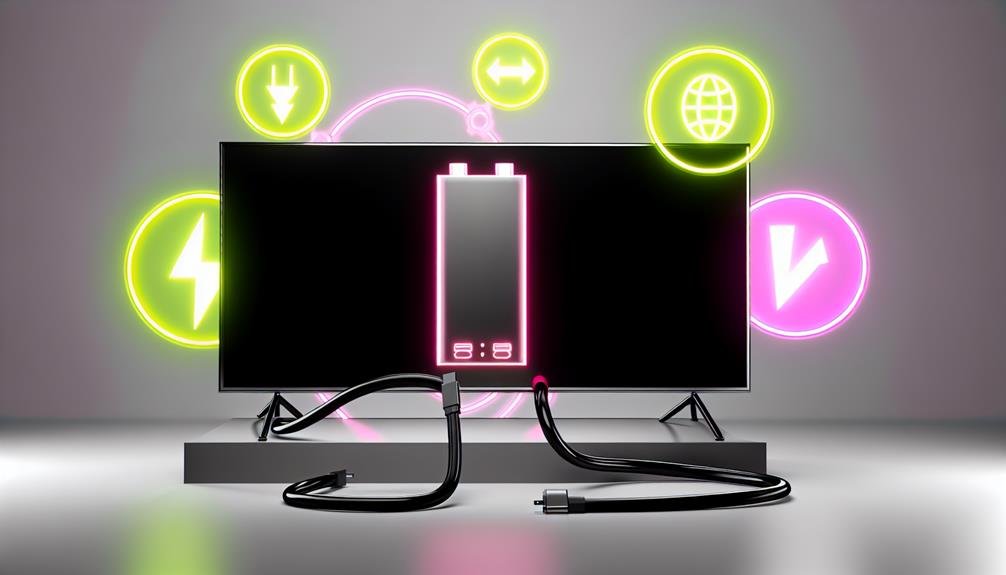
Several important compatibility factors must be considered to ensure a power bank can effectively power a TV. Initially, compatibility issues and charging speed are essential. Your TV's power input requirements must align with the power bank's output. If the TV demands more power than the power bank can deliver, it won't operate correctly. Additionally, charging speed impacts performance; a power bank with insufficient wattage will not sustain the TV, leading to intermittent power loss or inefficient operation.
Moreover, power bank limitations and voltage output play a crucial role. Different TVs require varying voltage levels to function correctly. It's essential to match the voltage output of the power bank to your TV's specifications to avoid damaging either device. Most TVs require a stable and specific voltage to operate safely.
Here's a quick reference table to help you understand these factors:
| Factor | Description | Importance Level |
|---|---|---|
| Compatibility Issues | TV's input vs. Power Bank's output | High |
| Charging Speed | Rate at which power is delivered | Medium |
| Power Bank Limitations | Maximum output capacity | High |
| Voltage Output | Required voltage for TV operation | Critical |
Power Bank Capacity
Assessing the power bank's capacity is essential to making sure it can provide sufficient power to run your TV for the desired duration. First, you'll need to understand the battery capacity, typically measured in milliampere-hours (mAh) or watt-hours (Wh). A higher capacity means more energy stored, translating to longer operational time for your TV.
To accurately evaluate if your power bank can power a TV, consider the following aspects:
- Battery Capacity: Confirm the power bank's capacity is sufficient by comparing it to your TV's energy consumption. A TV requiring 70 watts per hour will need a power bank with at least 70 Wh for every hour of desired usage.
- Charging Time: Factor in the charging time for your power bank. A higher capacity power bank will take longer to charge, impacting its readiness for use.
- Portable Devices: Evaluate if the power bank is designed for portable devices, as these are typically optimized for energy efficiency, ensuring minimal power loss during transfer.
- Energy Efficiency: Consider the energy efficiency of the power bank, which affects how effectively it can convert stored energy into usable power for your TV.
Voltage and Wattage
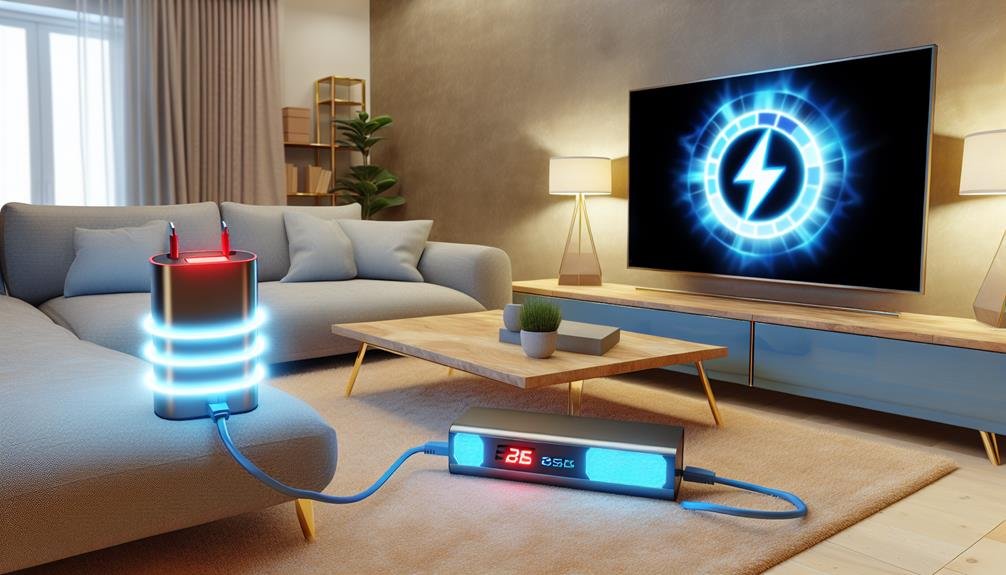
Understanding the voltage and wattage requirements of your TV is vital to guarantee that your power bank can deliver the necessary power efficiently. TVs typically require a specific voltage, often around 12V or 19V, and a certain wattage that can range from 30W to over 100W. Matching these requirements with your power bank's output is important to prevent damage and ensure best performance.
When selecting a power bank, consider its capacity limitations and whether it includes voltage regulation. Voltage regulation ensures a steady output, protecting your TV from potential spikes or drops that could cause harm. Additionally, you'll need to assess the power bank efficiency, which indicates how effectively it converts stored energy into usable power. Higher efficiency means more reliable performance and longer usage times.
Device compatibility is another crucial factor. Verify that your power bank has the appropriate connectors and output specifications to match your TV. Using an incompatible power source can result in inefficiency or even damage. Always consult your TV's manual and the power bank's specifications to ensure they align correctly. Adhering to these guidelines will help you safely and effectively power your TV with a power bank.
Types of TVs
When considering whether a power bank can power a TV, you'll need to understand the differences between LED and OLED displays, as well as the power requirements of Smart TV features. LED TVs typically consume less power than OLED TVs, but both types have different electrical demands. Additionally, Smart TVs with integrated Wi-Fi and streaming capabilities may draw more power, which impacts the feasibility of using a power bank.
LED Vs. OLED
Both LED and OLED TVs offer distinct advantages and technological features that can influence your viewing experience and power consumption. Understanding these differences is important for making an informed decision, especially when considering the use of a power bank.
OLED Benefits:
- Superior Picture Quality: OLED TVs provide deeper blacks and more vibrant colors due to their ability to turn off individual pixels.
- Energy Efficiency: OLEDs are generally more energy-efficient as they don't require backlighting, thereby potentially extending the life of your power bank.
- Thinner Design: Without the need for a bulky backlight, OLED TVs can be much thinner and lighter, making them easier to handle and safer to mount.
- Wider Viewing Angles: OLED technology ensures consistent picture quality from virtually any viewing angle, enhancing your overall viewing experience.
LED Drawbacks:
- Backlight Bleeding: LED TVs can suffer from uneven backlighting, resulting in less accurate blacks and reduced picture quality.
- Higher Power Consumption: LED TVs often consume more power due to their backlight, which can drain your power bank faster.
- Thicker Builds: LEDs require a backlight layer, making them generally bulkier compared to OLEDs.
- Limited Viewing Angles: Picture quality on LED TVs can degrade when viewed from off-center angles, affecting your viewing flexibility.
Smart TV Features
Smart TV features have revolutionized the way you interact with your television, offering a range of functionalities from streaming services to voice control. Modern Smart TVs come with built-in apps like Netflix, Hulu, and Disney+, enabling you to stream your favorite content directly without needing external devices. The seamless app integration enhances user experience by providing a central hub for all your entertainment needs.
Another significant feature is screen mirroring, which allows you to project your smartphone, tablet, or computer screen onto the TV. This is especially useful for presentations, viewing photos, or playing mobile games on a larger display. For added security, always make sure that your devices are connected to secure networks to protect against unauthorized access.
Voice control has also become a staple in Smart TVs, letting you manage your TV settings, search for content, and even control other smart home devices using simple voice commands. This hands-free operation reduces physical interaction, which can be a safety advantage, especially in households with children or elderly individuals.
Connection Methods
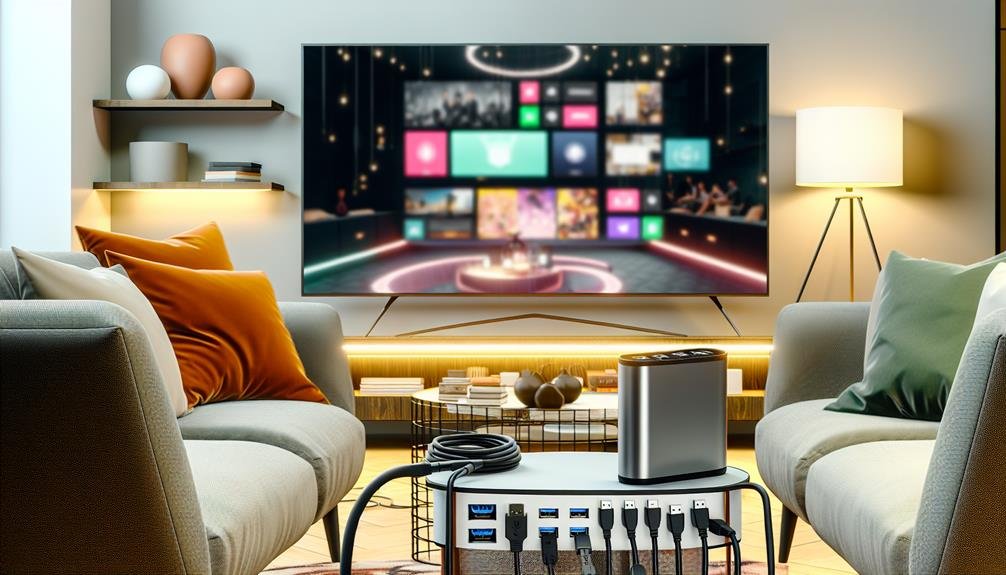
To connect a power bank to a TV, you'll need to make certain that both devices have compatible ports and appropriate cables. Here's a structured approach for ensuring a safe and effective connection:
- Identify Ports: Check if your TV has a USB-C or micro-USB input, which are common on power banks. HDMI inputs will require an adapter.
- Cable Compatibility: Use high-quality cables to prevent power loss and guarantee stable current flow. Mismatched cables can lead to ineffective charging or even damage.
- Voltage and Amperage Checks: Verify that the power bank's output matches the TV's power requirements. TVs typically need higher wattage, and using an underpowered bank could cause it to overheat or fail.
- Secure Connections: Confirm all connections are tight and stable. Loose connections can result in power fluctuations, risking both the power bank and the TV.
If you encounter issues, here are some troubleshooting tips: double-check connections, test with different cables, and confirm that both devices are functioning properly. Be mindful of power bank limitations; they may not sustain long-term use. Consider alternative solutions like portable power stations for extended viewing sessions. Prioritizing these steps will help you safely connect and power your TV using a power bank.
Real-World Scenarios
Understanding how to connect a power bank to a TV is essential, but it's equally important to examine real-world scenarios to gauge practicality and performance. If you're considering using a power bank, note that portable chargers have limitations. They are typically designed for low-power devices like smartphones or tablets. For instance, a standard 20,000mAh power bank might only provide a few hours of operation for a small TV. Larger TVs demand even more power, reducing operational time significantly.
In emergency power situations, a power bank might serve as a temporary solution, but it's not the most reliable. The efficiency of power conversion and the capacity of the power bank are critical factors. You should explore alternatives like portable generators or dedicated emergency power systems that can deliver sustained power over longer periods.
Evaluating real-world scenarios, consider how frequently you'll need to power your TV during outages or outdoor events. If you frequently face power disruptions, investing in a more robust emergency power source would be wise. Portable chargers can be a stopgap, but understanding their limitations ensures you won't be caught unprepared.
Safety Considerations
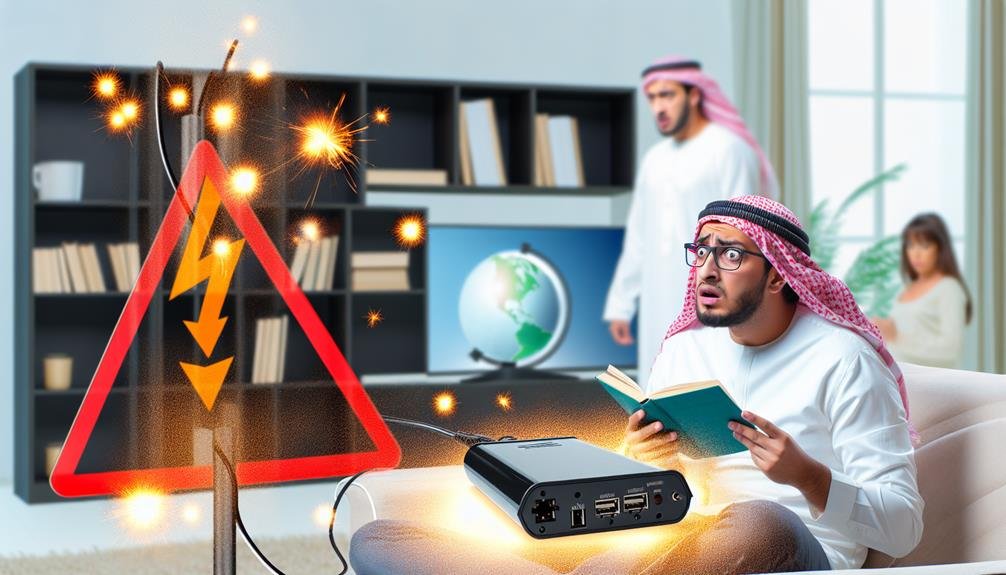
When using a power bank to power a TV, it's vital to take into account the safety risks associated with electrical incompatibilities and battery management. Battery safety should be your top priority to avoid potential hazards like overheating, short-circuiting, or even fires. Power banks have limitations that must be understood to guarantee safe operation.
- Voltage and Current Compatibility: Confirm that the power bank's output voltage and current align with the TV's requirements. Mismatched voltages can damage your TV or the power bank, presenting a fire hazard.
- Overload Protection: Utilize power banks equipped with overload protection to prevent the device from supplying more power than it can handle. This is essential for maintaining battery safety and avoiding overheating.
- Heat Management: Place the power bank in a well-ventilated area to help dissipate heat. Excessive heat can degrade the battery, leading to reduced efficiency and increased risk of malfunction.
- Battery Capacity: Select a power bank with a sufficient capacity to power the TV for your desired duration. Overworking a low-capacity power bank can strain the battery, resulting in quicker wear and potential safety issues.
Frequently Asked Questions
How Long Can a TV Run on a Fully Charged Power Bank?
To determine how long a TV can run on a fully charged power bank, you'll need to compare the power bank capacity with the TV's power consumption. Consider efficiency and battery life to guarantee safe and best usage.
Are There Specific Brands of Power Banks Recommended for Tvs?
Picture a key fitting perfectly into a lock. For power bank compatibility with your TV, consider brands like Anker or RAVPower. Guarantee the power bank's output matches your TV's power consumption to avoid risks.
Can Power Banks Damage a Tv's Internal Components?
Yes, using a power bank with incompatible voltage or current can damage a TV's internal components. To guarantee safety, verify power bank compatibility with your TV to minimize potential risks of overheating or electrical damage.
Is It Possible to Use a Power Bank While Charging It?
Notably, while it's possible to use a power bank while charging it, charging limitations affect power bank efficiency. You'll notice reduced performance, and it's safer to avoid this practice to guarantee both device and power bank longevity.
What Are the Signs of a Power Bank Overloading a Tv?
You'll notice voltage fluctuations causing screen flickering or TV shutdowns. These signs indicate potential damage and fire hazard. Address these safety concerns immediately to prevent overloading and guarantee the power bank's compatibility with your TV.



